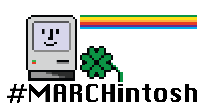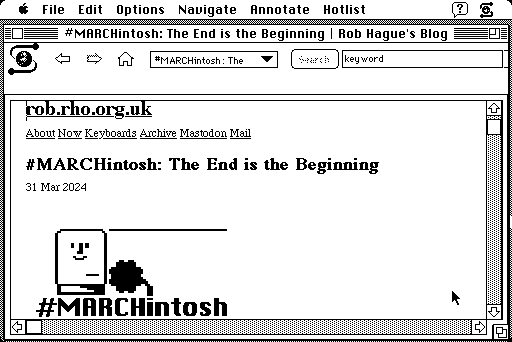#MARCHintosh: The End is the Beginning

In Friday’s post, I described how I’d tried various browsers, but MacWeb was the only one that could run on the very constrained setup I have. I was pleased to get something working, but the results were very basic. It looked like this was as far as I was going to get, but then I remembered one option that I’d not tried: NCSA Mosaic, the very first web browser I ever used (and one of the first anyone ever used).
Mosaic wasn’t the first browser, but it introduced a lot of features that now seem fundamental to the web: inline images, bookmarks, and history navigation. It was the first browser aimed at a broad user base, and was many people’s first experience of the web. Its preeminence was short-lived, however: a student working on the project (one Marc Andreessen) built on the foundations to make Netscape1, which marked the moment when then the web really exploded.
When I was an undergraduate, my usual haunt was the lab full of SparcStations and Windows/Netware PCs2. However, occasionally I’d pay a visit to the more general-use computer room on the floor below, which was intended not for Computer Scientists, but for students of all types to type up essays and check their email. There were more Windows PCs there, but there were also Macs, and it was on one of those that I think I first encountered both Mosaic and the web itself. This was a a long time ago, and I can’t recall the specific model of machine it was — I can’t even recall if the display was monochrome or colour — but I do recall a sense that the web was something very different, and something with a lot of potential.
Back in present day, it was a simple matter to find a period version of Mosaic on Macintosh Repository. Alas, the NCSA FTP archive they refer to no longer appears to be up, so I got it on to the SE via the SD card rather than Fetch, but once there it unpacked fine. I clicked on it with some trepidation, expecting it to fail with an error complaining about the lack of Open Transport, or requiring 8MB of RAM or a 68020, but… it worked! I entered the URL, and up came this site. After a short wait, it even rendered the #MARCHintosh GIF. The presentation was somewhat more polished than MacWeb as well — no CSS, obviously, but a usable if minimal view of the web.

(One interesting note — by default, Mosaic doesn’t show the URL, just the page title. This was a controversial change when Chrome and Safari made it a couple of years back, but it turns out to have a very long pedigree.)
This is pretty much exactly what I was hoping for when I kicked off the project at the start of the month. It seems especially fitting that, in the end, the solution has come full circle to my own first steps on the web.